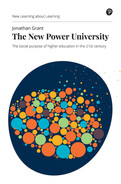In a changing world, what is the social purpose of higher education? Combining a critique of contemporary universities, a manifesto for the future and a provocation to stimulate change, The New Power University examines how higher education can flourish in the 21st century. Using the framing of ‘new power’, Jonathan Grant illustrates how a different purpose for universities is necessary, through the application of a new set of values that puts social responsibility at the core of the academic mission, allowing the university to become an advocate of the policy and political issues that matter to its communities. The New Power University offers both a warning against the complacency of old power and a voice for many who see the opportunity and necessity for radical change in higher education. ‘Jonathan Grant examines the trends and urges the shedding of old shibboleths in order to embrace a new future. Insightful and engaging, this book will spur and shape the urgent debates learning communities need to have and resolve to avoid being left behind.’ Julia Gillard, Former Australian Prime Minister and Minister for Education; Chair-elect of the Wellcome Trust ‘A must-read for anyone interested in the transformative power of higher education.’ Ed Byrne, Former President King’s College London; co-author of The University Challenge ‘The New Power University is essential material for anyone wondering what universities are for and how they can help provide the answers to the most pressing challenges of our times.’ Jo Johnson, Chairman of Tes Global; former UK Minister for Universities, Science and Innovation
Table of Contents
- Cover
- Title
- Copyright
- Contents
- Author's acknowledgements
- About the author
- Preface
- Part One The role of the university in the 21st century
- Part Two The Missions of a New Power University
- Part Three People, Power and Voice
- Part Four The Conduct of The New Power University
- Postface
- Appendix 1: Analysis of Gen Z students and non-students
- Appendix 2: Responses from non-Anglo countries to the challenge of current university staffing, and the proposed solutions
- References
- Index
- Publisher's acknowledgements
